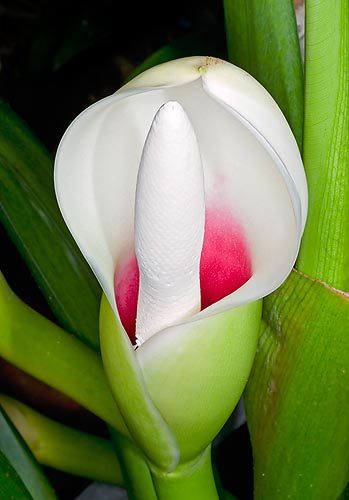Family : Araceae

Text © Pietro Puccio

English translation by Mario Beltramini

A 15 cm spathe and a purple red throat © Giuseppe Mazza
The Philodendron martianum Engl. (1899) is native to the pluvial forests of south-eastern Brazil.
The name of the genus is the combination of the Greek words “philos” = friend, and “déndron” = tree, with reference to the usually climbing appearance of the plants belonging to this genus; the species is honoured to the German botanist Carl Friedrich Philipp von Martius (1794-1868).
Common names: “flask philodendron”, “Von Martius’ philodendron” (English); “babosa-de-pau”, “babosa-de-árvore”, “babosa do Mato”, “pacová” (Portuguese).
Semi-epiphytic, climbing, evergreen herbaceous, it presents short stems with close inter-nodes and dark green ovate leaves, rather coriaceous, long up to about 45 cm and 15-20 cm broad, on petioles almost spindle-shaped, spongy inside.
The single axillar inflorescences are formed by an about 15 cm long spathe, of yellowish green colour externally, greenish white internally in the upper part, purple red in the lower one, and by a white spadix; the flowers are unisexual, protogynous (the female flowers are receptive before the male ones ripe, thus avoiding self-fertilization), in particular, the male flowers occupy the upper part of the spadix, whilst the female ones are grouped in the inferior part.
It usually reproduces by seed or by division. The plant can be cultivated in open air in the tropical and humid subtropical regions, where it is often utilized in shady locations for covering the soil. When in pot, it bears for long time poorly luminous situations; it needs very porous, draining and rich of organic substance substrata, and temperatures over the 14-16°C, best around 20-22°C; watering must be frequent in summer, reduced in winter, always avoiding water stagnations which can generate rottenness.
All parts of the plant contain toxic substances, in particular, calcium oxalate, which can be irritating.
Synonyms: Philodendron cannifolium Mart. ex Kunth (1841); Caladium macropus Kunth (1841); Caladium crassipes Engl. (1879).
